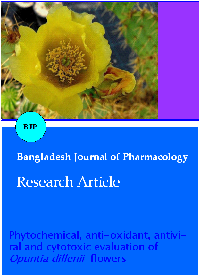Phytochemical, antioxidant, antiviral and cytotoxic evaluation of Opuntia dillenii flowers
DOI:
https://doi.org/10.3329/bjp.v9i3.19489Keywords:
Antioxidant, Antiviral, Cytotoxicy, Opuntia dillenii, PhytochemicalAbstract
Opuntia dillenii used in Asian traditional medicine especially in China. We here report on the investigation of the phytochemical content, antioxidant, cytotoxicity and antiviral activity of methanolic extract of O. dillenii flowers. The antioxidant activity was measured with the DPPH, hydrogen peroxide and hydroxyl radicals scavenging method. In the antiviral and cytotoxic assay we used different viruses in different cell lines. In antioxidant assay, the DPPH assay exhibited potent antioxidant abilities with IC50 of 58.7 µg/mL. In antiviral assay, the extract possess strongest antiviral activity against herpes simplex 1(EC50= 25 µg/mL) and 2 (EC50= 20 µg/mL), vaccinia (EC50= 100 µg/mL) and moderate activity for remaining viruses (EC50= >100 µg/mL). The cytotoxicity effect was evaluated using MTT assay and the results revealed that the extracts exhibited cytotoxicity above the range of 100 µg/mL. Our present reports confirmed that the O. dillenii could be a potential antioxidant and antimicrobial agent in near future.
Downloads
745
396 Read
26

Published
How to Cite
Issue
Section
License
Authors who publish with this journal agree to the following terms:
- Authors retain copyright and grant the journal right of first publication with the work simultaneously licensed under a Creative Commons Attribution License that allows others to share the work with an acknowledgement of the work's authorship and initial publication in this journal.
- Authors are able to enter into separate, additional contractual arrangements for the non-exclusive distribution of the journal's published version of the work (e.g., post it to an institutional repository or publish it in a book), with an acknowledgement of its initial publication in this journal.
- Authors are permitted and encouraged to post their work online (e.g., in institutional repositories or on their website) prior to and during the submission process, as it can lead to productive exchanges, as well as earlier and greater citation of published work (See The Effect of Open Access).
